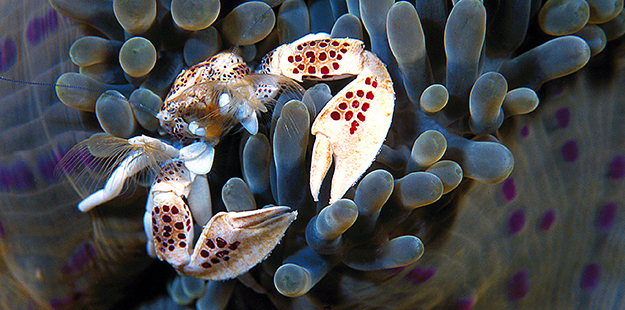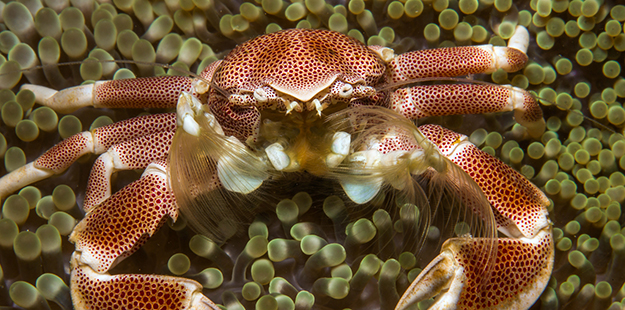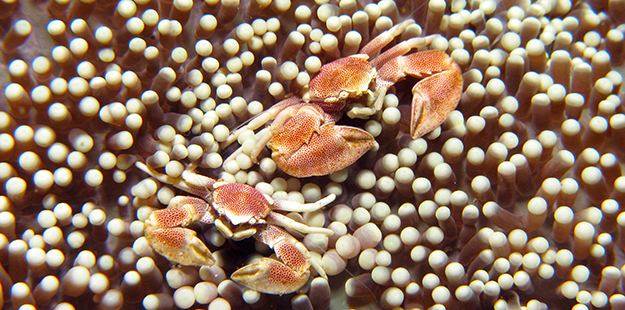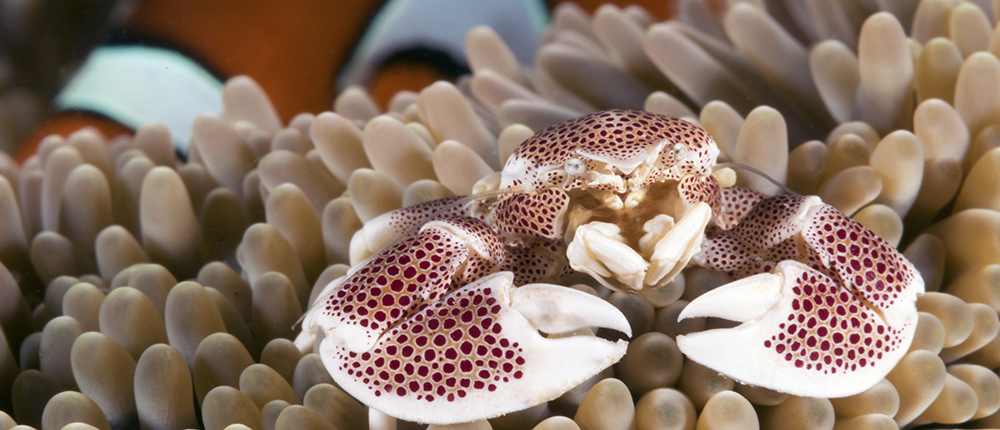Wakatobi’s Porcelain Treasures
Taking a closer look at one of Wakatobi’s less celebrated anemone dwellers: the porcelain crab.
You don’t have to swim far to find sea anemones on the reefs around Wakatobi Resort. Just yards from the resort jetty, a colorful carpet of these stationary predators adorn the slopes of the House Reef, and similar colonies are found on all of the signature sites within the resort’s private marine preserve. In addition to adding color and variety to the seascapes, anemones provide shelter for a range of commensal and symbiotic tenants. Best known are the clownfish, which remain a favorite with photographers. A closer look may reveal delicate shrimp tucked among the protective tentacles, and there’s also a good chance you’ll find one or more clawed critters.

Porcelain crabs are related to squat lobsters and are labeled by biologists as decapod crustaceans in the Porcellanidae family. Photo by Doug Richardson
Examine an anemone in Wakatobi waters, and there’s a good chance it will be playing host to one or more spotted porcelain crabs. Purists would say these are not true crabs, as they have somewhat elongated bodies and only three pairs of walking legs rather than four. Biologists label them as decapod crustaceans in the Porcellanidae family and note that they are related to squat lobsters. But given their proportionately large claws and general crab-like appearance, this academic distinction isn’t of much interest to most observers.
Their prominent claws are not used to pick apart detritus or snag prey, and are instead reserved for defensive protection and territorial fights with other members of their species.
What does separate porcelain crabs from their bottom-scuttling cousins is their feeding habits. Their prominent claws are not used to pick apart detritus or snag prey and are instead reserved for defensive protection and territorial fights with other members of their species.

When feeding, the porcelain crab flicks it’s lacey fans to snare tiny morsels of plankton from the water. Photo by Marcus Lindenlaub
Porcelain crabs are actually filter feeders, and they have evolved a unique set of feeding tools that can be extended from the corners of their mouths. When feeding, they will flick these fine-laced fans about like a pair of badminton rackets, snaring tiny plankton morsels from the surrounding water. It is during this feeding activity that you are most likely to see a porcelain crab, as this is when they will climb to the outer extremities of their host anemone in order to extend their feeders into the surrounding water column. When mealtime is over, they usually retreat deeper into the mantle of the anemone, and are harder to spot among the tentacles.
Often growing to the size of a one Euro coin, these crabs are easily spotted with the naked eye. With a whitish colored body with red dots surrounded by a lighter red color, they make for interesting macro subjects, particularly when they have recently molted, and their shiny new shells are free of algae growth.

These crabs are often found in pairs and photographers stand a good chance of getting both in the frame. Photo by Ye Choh Wah
A 50 or 60 mm lens is ideal for capturing portraits, and the photographer’s main challenge will be moving close without disturbing the crab, which will likely duck deeper into the anemone if it feels threatened. Because these crabs are often found in pairs, there’s also a chance of getting both in the frame, or possibly adding a clownfish to the composition. In general, anemone-dwelling clownfish ignore their crabby neighbors, save for those times when the fish are laying eggs, and become highly territorial. Crabs, on the other hand, aren’t overprotective parents, and you may notice the females carrying a clutch of eggs as they move about the tentacles of their host.
Take a closer look at porcelain crabs and the thousands more unique varieties of marine life that call the reefs of Wakatobi home. Start by contacting our office at office@wakatobi.com, or complete a quick trip inquiry at wakatobi.com. A guest experience consultant will be in touch with you to answer questions and provide information about your dive vacation of a lifetime.
Visit us on Facebook and Instagram
Wakatobi on YouTube
Contact us – Enquire


